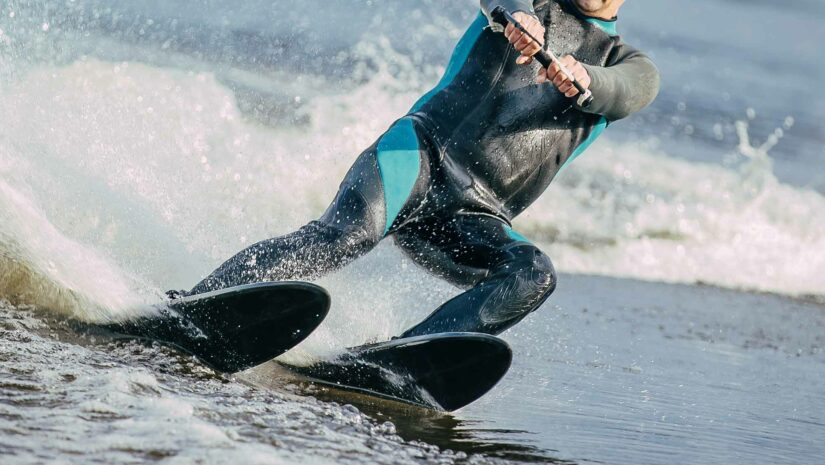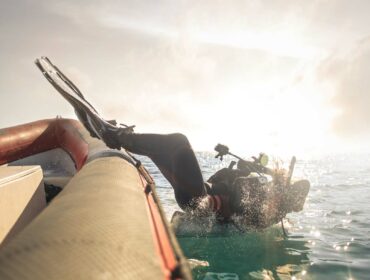Water skiing is a surface water sport that may be purely recreational or competitive. It involves balancing on skiboards while being dragged by a motorboat to plane, jump, and perform tricks on water.
The first attempts to water ski were done on Lake Pepin in Lake City, Minnesota, by Ralph Samuelson when he was only 18 years old. After numerous runs, Samuelson successfully invented the sport on July 2, 1922, after he discovered that leaning backwards with ski tips slightly poking out of the water was the most effective way to stay afloat.
Today, water skiing is popular among people of different age groups, and is recognized by the Olympics and all major water sports championships. Aside from enjoyment, regular skiers are granted multiple health benefits like great overall muscle tone and improved balance.
Water Skiing Equipment
Before anything else, you need to make sure you have the right gear for a safe and pleasant experience. Generally, weight is the deciding factor that dictates how long a water skiboard should be. Heavier riders require lengthier boards, but could make do with smaller ones when towed at high speeds. For beginners, combo skis are recommended as they provide the most stability and directional control. They come in sets of two boards, each with adjustable ankle bindings. Once you’re a little more experienced, you can retire one of the water skis and use the half with a rear toe plate for slalom water skiing.
The desired speed of the skier and the shape of the water ski are also considered when choosing water skiing equipment. Longer boards allow faster speeds and better footing, while shorter boards respond to turning maneuvers more quickly. In terms of form, water skiboards with a narrow tunnel bottom fare best on rough waters, while edge-to-edge concave bottoms help you make effortless hard turns.
Check out this video on how to select the most appropriate gear:
How to Water Ski
Proper Grip and Posture
Water skiing is all about maintaining the proper stance to stay above water level. The basic positions you need to know are the cannonball and the chair position. When skiing with two water skiboards, the proper grip on the handle is the knuckles up grip.
Before Getting in the Water
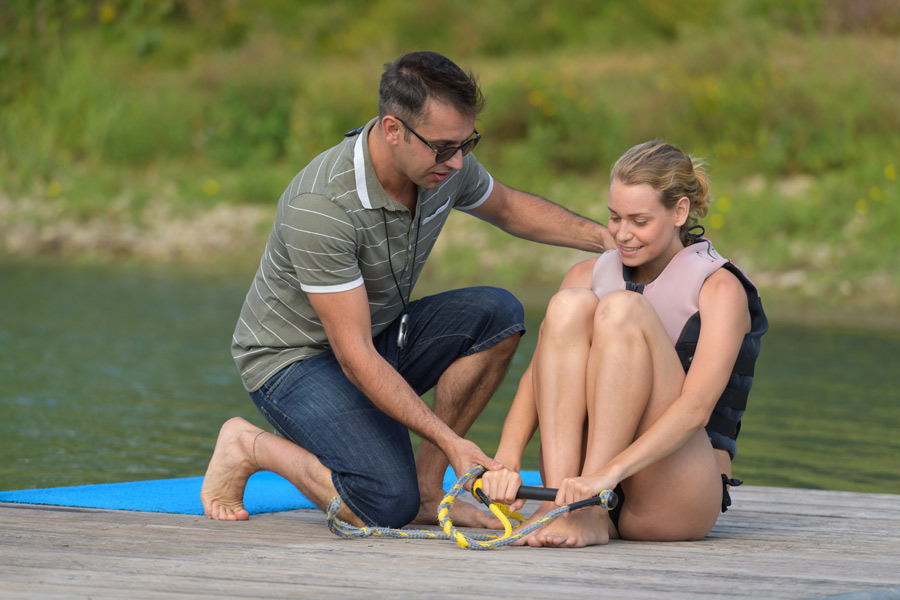
Demonstrating the right body postures on land is a standard practice that must be followed by everyone who is new to the sport. The cannonball position gives you a feel of how it’s like to be towed by a boat before starting to water ski. This is done by assuming a seated position where your knees are kept together at the level of your chest. Once you’re comfortable, grab onto the rope handle with both hands, knuckles facing upward (knuckles up grip), and arms on the outer side of your legs. Preferably, the other end of the rope should be held by an instructor or friend.
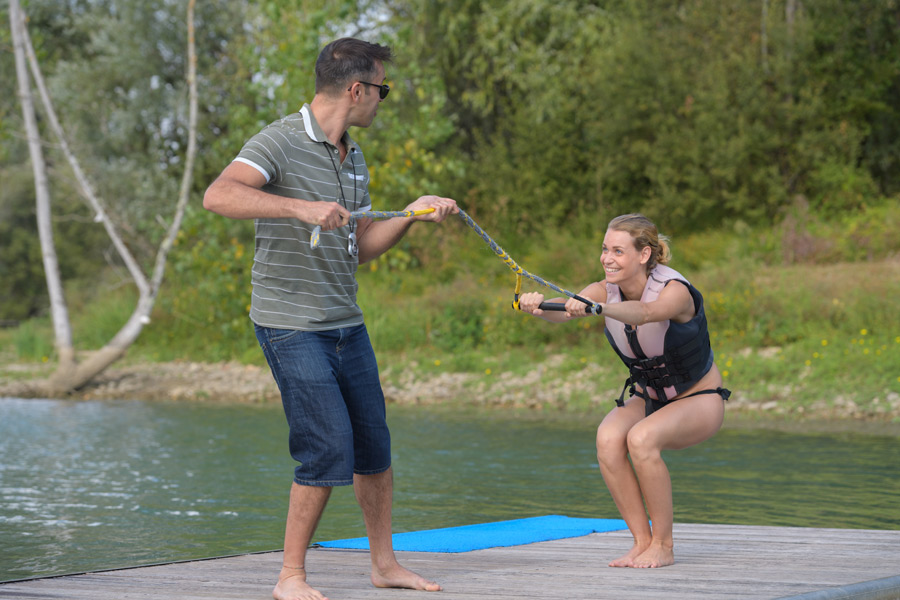
When you’re ready, ask the other person to gradually pull on the rope as if mimicking the force of a motorboat. Let this motion raise you up to the chair position while keeping your arms straight and firm. The said stance involves bent knees, raised shoulders, straight arms, and eyes focused straight ahead. Repeat this several times until you are confident with transitioning from the cannonball position to the chair position on land. You can also strap into your water skiboards as you practice.
Deep Water Start
When performing a deep water start, assume the cannonball position while submerged in water. Let your combo skis float in front of you, with the rope dangling in between the two boards. Signal the boat driver to start, and transition into the chair position as you are slowly pulled out of the water. Remember to let the boat do the work for you. Do not force yourself up by tugging on the handle with your arms or you will lose your balance and fall.
Watch this video to see how a deep water start is pulled off:
Dock Start
A dock start is done by standing on a dock or dry ground and getting dragged into the water by the boat. Ideally, the starting point should be close to the surface of the water so you could get a better stance the moment you land. When attempting a dock start, you don’t have to get into the cannonball position. Instead, you can sit on the dock or stand with a straight back as the boat reels you in. The key to a successful start of this nature is being mindful of how far the rope has already stretched out and keeping your arms partially bent inwards to absorb the initial shock from the pull.
While in Motion
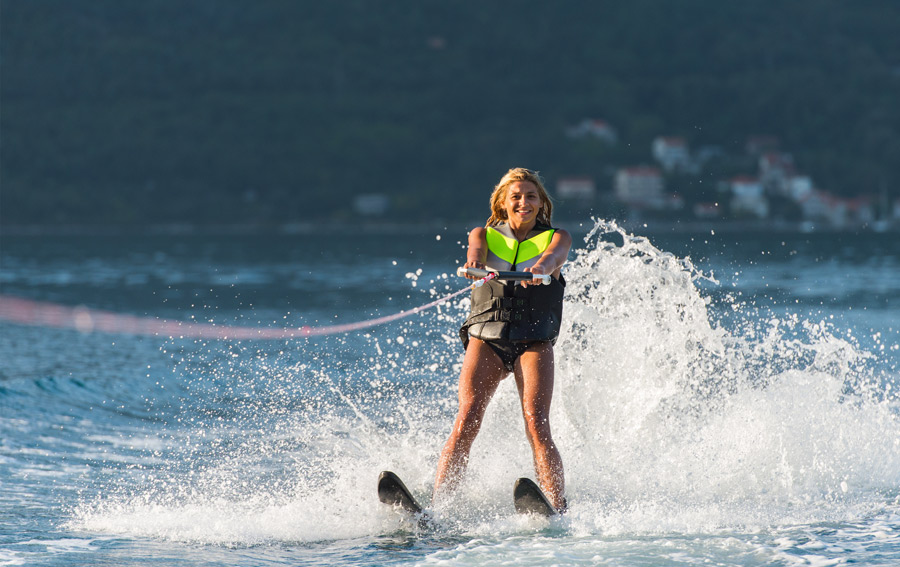
Remain in the chair position until you are comfortable to put your hips underneath your shoulders. You’re going to want to keep your arms straight while your ankles and knees are bent to prevent falling out of balance. You should also look straight ahead instead of down on the water, and apply a bit of downward force on the handle.
The longer you’re in motion, the more tempting it would be to pull yourself forward with the rope or straighten your knees—both of which will throw you off balance. Basic water skiing doesn’t require you to make adjustments to your stance as your cruise through the water. In fact, it should feel almost effortless. If not, you are probably too tense and have to remind yourself that the boat should do all the work for you while you stick to the proper body position.
Turning
To steer your water skis, bend your knees more on the skiboard opposite the direction you want to go. The goal is to put more pressure on the inside edge of one water ski while slightly unweighing your foot from the other board. So if you want to turn left, bend your right knee and relieve pressure from your left while leaning towards the intended direction.
Crossing over the boat wake should be done swiftly with both skis, as going too slowly or attempting to cross the wake one ski at a time will result in a fall. Approach the wake of the boat at a sharp angle and put pressure on the ski furthest from the waves until you’re completely over them. For a successful crossover, bend your knees an additional amount to help absorb shocks.
Watch this video to learn more about turning and crossing the wake of the boat with water skis:
Slalom Skiing
Slalom water skiing refers to water skiing with only one board. This should only be done once you are confident with riding on combo skis. It involves strapping your non-dominant foot onto the binding and placing your dominant foot at the back or on the rear toe plate to control balance and directionality.
When you’re just starting out, you can use the knuckles up grip to hold the handle and then advance to the baseball grip when you are more practiced. This involves having your hand on the same side of your dominant foot facing down while the other faces up.
Play this water skiing video to learn how to do a slalom deep water start:
And this video to learn how to stand on a slalom ski:
Observe the Safety Code
- Wear a properly fitted life vest or life jacket at all times.
- Only use water skiing equipment that is in good condition.
- Give the starting signal only when you are ready.
- Water ski only in designated areas without ships, pilings, or swimmers.
- Never water ski in shallow water to avoid hitting obstructions close to the surface.
- Try as much as possible to fall on your back or to the side.
- Memorize water skiing hand signals and communicate that you are doing okay after a fall.
- Do not ski after sundown.
Additional Reminders
- Check the rope for frays before heading out to the water.
- If you feel yourself about to lose balance, let go of the rope to avoid getting dragged by the boat in improper form.
- Make sure there is an observer in the towboat.

